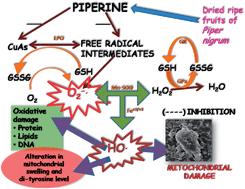Protective effects of piperine against copper-ascorbate induced toxic injury to goat cardiac mitochondria in vitro
Abstract
Piperine, the main alkaloid of black pepper, Piper nigrum Linn., is an important Indian spice used in traditional food and medicine in India. In the present study, we investigated the antioxidant activities of piperine against copper-ascorbate induced toxic injury to mitochondria obtained from a goat heart, in vitro. Incubation of isolated cardiac mitochondria with copper-ascorbate resulted in elevated levels of lipid peroxidation and protein carbonylation of the mitochondrial membrane, a reduced level of mitochondrial GSH and altered status of antioxidant enzymes as well as decreased activities of pyruvate dehydrogenase and the Kreb's cycle enzymes, altered mitochondrial morphology, mitochondrial swelling, di-tyrosine level and mitochondrial DNA damage. All these changes were found to be ameliorated when the cardiac mitochondria were co-incubated with copper-ascorbate and piperine, in vitro. Piperine, in our in vitro experiments, was found to scavenge hydrogen peroxide, superoxide anion free radicals, hydroxyl radicals and DPPH radicals, in a chemically defined system, indicating that this compound may provide protection to cardiac mitochondria against copper-ascorbate induced toxic injury through its antioxidant activities. The results of this study suggest that piperine may be considered as a future therapeutic antioxidant and may be used singly or as a co-therapeutic in the treatment of diseases associated with mitochondrial oxidative stress.


 Please wait while we load your content...
Please wait while we load your content...